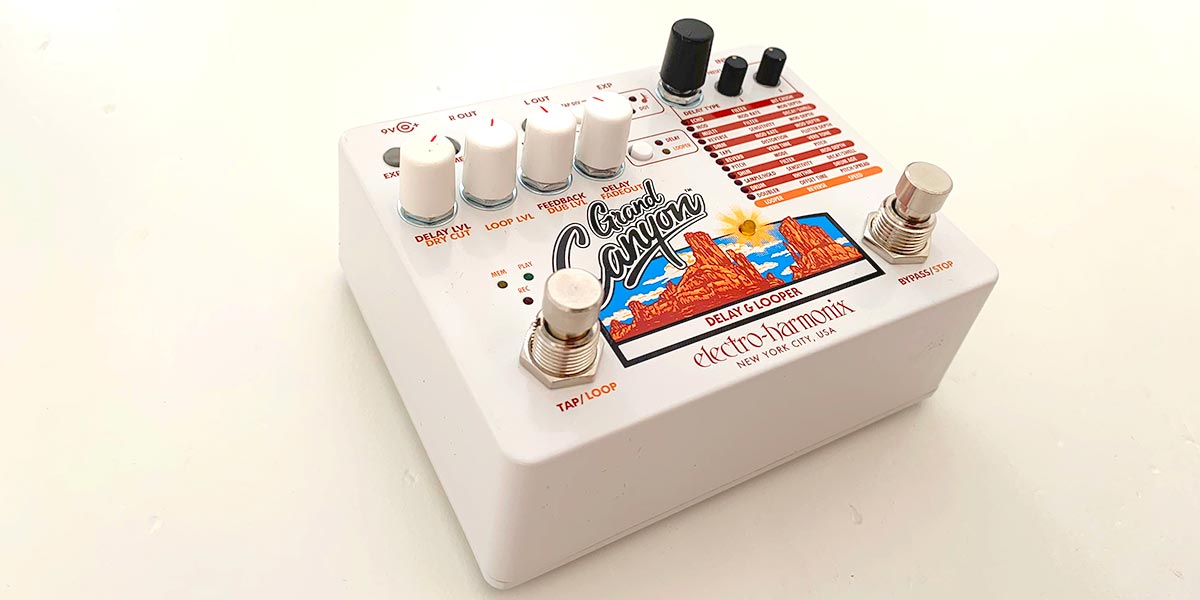
The delay pedal is one of the most used effects by guitarists. Only the overdrive pedal is used more often.
Almost every guitarist has one (or more) delays on his pedal board. The range of delay pedals is overwhelming and especially for beginning guitarists, the search for a suitable delay is comparable to finding a needle in a haystack. To make the search a little easier, this article contains an overview of different types of delay and their pedals.
Tape-delay
The Echonsonic amplifier featured one of the first portable delays. This delay was based on a so-called tape echo. The Watkins Copycat and the Maestro Echoplex were the first standalone delay units and came on the market in the late 1950s. Both used a technique where a magnetic tape recorded the incoming signal and then played it back.
Maestro Echoplex
The Echoplex, designed by Mike Battle in 1959, improved the Echosonic’s tape echo and allowed for setting delay rates. Later models had volume knobs that set the delay and original signal. Notable users of the Echoplex have included Brian May, Jimmy Page, and Les Paul. Today there are guitar pedals that mimic this tape echo effect. Catalinbread’s pedals in particular are known as some of the best on the market. The Catalinbread Belle Epoch and the Catalinbread Belle Epoch Deluxe are accurate emulations of the Echoplex EP-3. Eric Johnson is one of the most famous users of these pedals.

Watkins Copicat and Roland Space Echo
The Watkins Copicat came on the market more or less at the same time as the Echoplex. The very first units used tubing (two ECC83s and a 6BR8). These tubes were replaced in later versions by a Solid State technique. The reliability of the tubes in the device sometimes left something to be desired. In the 1970s, the Roland Space Echo arrived. The most famous is the RE-201 from 1974. This tape delay also contains a spring reverb that made reverb possible. It gave guitarists more room to experiment and the device is still produced, but in a digital pedal variant: the Boss RE-20.
Binson Echorec
The Binson Echorec should not go unmentioned either. It’s not a tape delay but it does use magnetism. Instead of tape, a magnetic drum rotates in the Echorec. This variant is also called a drum delay. Notable users include Brian Eno, Robert Fripp and David Gilmour. Nowadays there are guitar pedals on the market that are based on the Echorec, the two most famous are the Foxgear Echosex Baby and the Catalinbread Echorec.

Furthermore, there are several pedals on the market that are based on the tape delay effect, including the Wampler Faux Tape Echo and Keeley Eccos and Strymon Volante.
Analog delay pedal, bucket brigade
Introducing Bucket Brigade chips in the 1970s are the prelude to the development of analog delay pedals. Many of these pedals are now so famous that almost everyone knows one. The Memory Man by Electro Harmonix is one of the best known. With these pedals, the signal is passed in a number of phases, just like a human chain passing buckets in a fire. The result is a warm and analog sounding delay effect. Delay effect times were limited and were usually between a maximum of 300 and 500 milliseconds.
In the 1970s, Electro Harmonix launched the Memory Man, which would be widely used by the Edge and later by the Radiohead guitarists. Other classic pedals from this period include the MXR Analog Delay and Boss DM-1 and DM-2. In addition, analog delay pedals are still being marketed today. Think of the JHS Panther Cub V2 and the Chase Bliss Audio Tonal Recall, which features a fully analog signal path as well as digital (MIDI) control.
Digital delay pedal
The digital delay pedal came on the market in the 1980s. This pedal made it possible to produce an exact copy of the original signal as an echo. A digital delay repeats almost the exact sound that goes into it. These pedals use digital sampling technique in which the original signal is sampled and played back in slow motion. This made long delay times possible, nowadays even up to a few seconds(!).
The first digital delay pedals were not as good as the pedals on the market today. However, that also has its charm. Many of the early digital delay pedals have a resolution of only 4 or 8 bits. The echoes then tend to ‘decay’ and deteriorate, but in a musical way. The sound then goes back a bit towards an analog delay.
One of the most famous digital delay pedals is the Boss DD-2, the pedal that started it all. Nowadays every reputable brand has a digital delay pedal. Some well-known and widely sold pedals are: Strymon Timeline, Electro Harmonix Nano Canyon, Electro Harmonix Grand Canyon, Eartquaker Devices Avalanche Run, Meris Polymoon, JHS Lucky Cat, Keeley Caverns and, J Rockett Immortal Echo.
